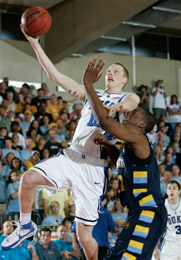Basketball Fitness
Since its first game, played in Massachusetts in 1891, basketball has made its way into nearly every high school and college sports program, and has established itself in the field of professional and Olympic competition as well. Basketball can be played either indoors in a stadium or gym or outdoors on a paved court. In general, the basic rules and regulations of basketball do not change across the varying venues and/or locations. However, when moving from one type on playing location to another it is always a good idea to review the rules beforehand. No equipment (besides good shoes, comfortable clothes and the ball itself) is required. However, most organized games use uniforms that are tailored specifically for the play of the sport. Some participants choose to wear additional gear such as face guards and sweat bands. This type of apparel is acceptable and often considered necessary depending on the player's preference. Players will be expected to sprint for distances of up to approximately 90 feet. Changing directions quickly and maintaining balance are also paramount to proper play. Participants are expected to hold their hands above their heads for extended periods of time. For these reasons, agility, balance, speed, and upper body strength (particularly in the arms and shoulders) are necessary for success. Playing The GameBasketball consists of two teams (5 active players each) competing to throw an inflated rubber ball through a basket that is raised 10 feet into the air. Each team has a basket at their end of the court. The team that has the most points at the end of the time allotted for the game is declared the winner. The duration of the basketball game is dependent on the level at which the game is being played. Below are the typical game times for the various levels basketball:
The size of the area of play (the court) also varies across the different levels of basketball, and are as follows:
Referees control the correct playing of the game. Players may receive violations (a foul) if they commit any of the following:
There are several types of shots that award a different numbers of points when made:
Fouls are called by referees and result in a number (1-3 depending on the foul) of free throws. Free throws are shots taken from the free throw line that no player is allowed to block or hinder. Some fouls include:
Training For BasketballOne of the most important aspects of playing basketball is the ability to change directions quickly and adapt to the play. For this reason, a complete basketball fitness/training program designed to increase an individual's endurance and agility has been provided below. Exercise 1

Exercise 2
Exercise 3
Common Injuries Associated With BasketballPatellar Tendonitis (Jumper's Knee): This injury is caused by overusing the knee, and is signaled by pain directly beneath the knee cap. The patella ligament is the ligament that connects the tibia bone to the knee cap. When jumping repeatedly, a large amount of strain is put on this ligament and can result in a rupture. The rupture will sometimes result in degenerative tissue and inflamed muscles. Common symptoms include discomfort when pressing on the knee cap, stiff and aching knees after a competition and discomfort when stretching the quadriceps muscles. Depending on the severity of the injury, ice and rest may be necessary for several days. Once the pain begins to subside, the rest period can be shortened and heat can be applied. Impingement: Often occurs in basketball and is frequent in the shoulder. Impingement occurs when the space containing the rotator cuff and tendons of the biceps narrows. When a players arm's are raised over their head, the tendons may become constricted, resulting in a limiting of the range of motion and discomfort. Depending on the severity of the injury, ice and rest may be necessary for several days. Once the pain begins to subside, the rest period can be shortened and heat can be applied. Nutritional Information for Basketball PlayersConsume five to six smaller meals each day. By doing so, the body will be consistently replenished with energy and nutrition throughout the day. The first 15 minutes after strenuous exercise are the most crucial for restoring carbohydrates and building glucose reserves. Fruit juices contain more carbohydrates per ounce than drinks made for sports like Gatorade (although Gatorade has been designed to safely and healthily restore energy supplies and is acceptable). 
After playing a game of basketball, try to consume one-half grams of carbohydrates and one-eighth grams of a protein per each pound of body weight. Females should consider a 250-300 calorie snack after working out, while males should consume a snack closer to 350 or 400 calories after their activity. Your daily intake of protein should consist of 1.6 to 1.8 grams per each kilogram that a person weighs (remember that one kilogram equals 2.2 pounds). The amount of protein needed for active individuals may even increase to 2 grams per kilogram of weight. For inactive people the ratio is 0.8 grams per kilogram of body weight, much lower than what a typical basketball player will need. By ensuring that you maintain a healthy balance between carbohydrates, fats and proteins, you will give your body all the energy and nutrients it needs to effectively participate in the game of basketball. Carbohydrates (50-60%) come from vegetables, grains, bean products and fruit. Proteins (15-20%) can be obtained in lean cuts of meat like beef, chicken, fish and turkey. Healthy fats (20-30%) can be found in olive oil, legumes, avocados and most seeds. It is not only important to consume a diet that is balanced (carbohydrates to fats to proteins), but derived from natural, whole foods that are unprocessed and free of pesticides, chemicals and toxins as well. |
Copyright © 2024 FitnessHealth101.com All Rights Reserved
FITNESS TOPICS
FITNESS REVIEWS
FITNESS & HEALTH GLOSSARIES

